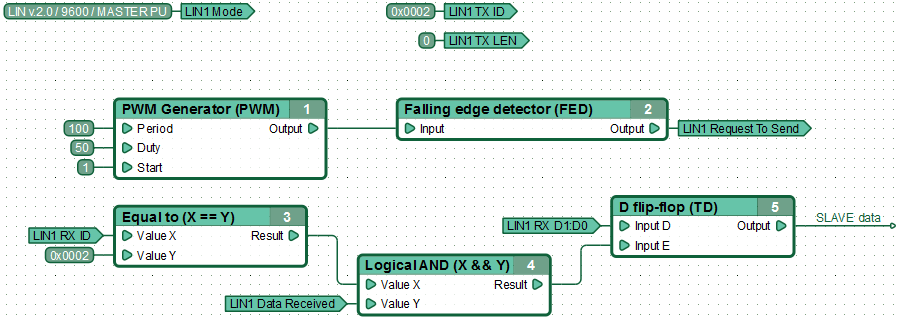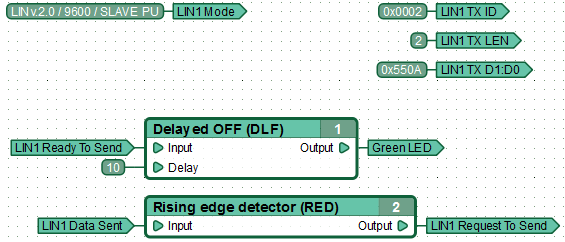General description
Two of eleven input-output channels of CANNY 7, which can be placed under control of UART/RS-232 driver (Channel №9 and №10), can be used to organize data reception and transmission as two independent LIN driver channels.
LIN driver channels can be connect both together and individually, have individual baud rate settings , pull-up line and bus node type- MASTER or SLAVE.
LIN driver in its operation uses the resources of controller channels, but has a higher priority than discrete input-output driver. Thus, upon LIN driver activation, for the involved channels in its operation, changing values in registers associated controllers' discrete input-output driver will be ignored.
Driver registers
The following describes the acceptable LIN driver operation control registers values.
LIN driver configuration Registers allows to set up the controller as a LIN bus node:
| Address
|
Expected values
|
| LIN1 Mode Setup Register
|
| LIN2 Mode Setup Register
|
|
| 1...65535
|
=
|
setup a LIN driver channel configuration, determines the current operation mode and parameters (determined by special constant from the constants directory);
|
| 0
|
=
|
disconnect the channel from the LIN driver, return channel control to input-output channels driver and allow its status changes from the functional diagram.
|
|
Channel configuration for operation in this mode is determined by a constant, which is a combination of parameters: protocol version , baud rate, operation mode and the availability of internal channel pull-up.
| Parameter
|
The list of acceptable values
|
| LIN protocol version
|
1.3; 2.0
|
| baud rate
|
2400; 9600; 19200
|
| Operation mode
|
MASTER; SLAVE
|
| Pull-up
|
plus; float
|
Named constants that represent LIN configuration parameters combination, available to the user in the "LIN Modes" CannyLab constants directory, which can be accessed via function block entry context menu having "constant" type.
LIN driver diagnostic registers.
| Address
|
Return Values
|
| LIN1 Overflow Register
|
| LIN2 Overflow Register
|
|
| 1
|
=
|
corresponding channel LIN buffer is full;
|
| 0
|
=
|
corresponding channel LIN no buffer overflow detected.
|
|
| LIN1 Error Register
|
| LIN2 Error Register
|
|
| 1
|
=
|
during LIN data reception an error occurred;
|
| 0
|
=
|
the driver is operating normally.
|
|
| LIN1 Ready to Send Register
|
| LIN2 Ready to Send Register
|
|
| 1
|
=
|
corresponding channel LIN data transmit buffer is free and ready;
|
| 0
|
=
|
LIN driver data transmission buffer is busy.
|
|
| LIN1 Data Delivered Register
|
| LIN2 Data Delivered Register
|
|
| 1
|
=
|
in SLAVE mode, successful data transfer indication from the buffer of corresponding channel LIN, in response to MASTER node request;
|
| 0
|
=
|
when the corresponding LIN channel is in a SLAVE mode, there were no MASTER node request received.
|
|
LIN Receive Registers.
| Address
|
Return Values
|
| LIN1 Data Set Ready Register
|
| LIN2 Data Set Ready Register
|
|
| 1
|
=
|
the message is received and placed into corresponding LIN channel receive buffer;
|
| 0
|
=
|
in the corresponding LIN channel receive buffer no actual data present.
|
|
| LIN1 Idle Register
|
| LIN2 Idle Register
|
|
| 1
|
=
|
no activity on the corresponding channel LIN drivers, the line is in a passive mode;
|
| 0
|
=
|
fixed activity on the line of corresponding LIN driver channel.
|
|
| LIN1 Received Data Register LEN
|
| LIN2 Received Data Register LEN
|
|
| 0...8
|
=
|
a value, equal to the number of data bytes in the packet received via respective LIN channel.
|
|
| LIN1 Received Data Register ID
|
| LIN2 Received Data Register ID
|
|
| 0...63
|
=
|
message ID, obtained via respective channel LIN . (See note.)
|
|
| LIN1 Received Data Register b1:b0
|
| ...
|
| LIN1 Received Data Register b7:b6
|
| LIN2 Received Data Register b1:b0
|
| ...
|
| LIN2 Received Data Register b7:b6
|
|
| 0...65535
|
=
|
respective data byte values, LIN reception buffers of each channel by two bytes to the register.
|
|
| Note:
|
LIN Received Data Register ID displays only the lower 6 bits of the identifier: 4-bit address of the device and the 2- bits used in the LIN 1.1 to encode the message length, and later to expand the address. 10 higher bits of LIN received message ID register always zero.
|
LIN transmit registers.
| Адрес
|
Expected Values
|
| LIN1 Request to Send Register
|
| LIN2 Request to Send Register
|
|
| 1
|
=
|
to load data from the transfer registers in the respective channel LIN transmit buffer;
|
| 0
|
=
|
do not load data to the respective channel LIN transmit buffer.
|
|
| LIN1 Transmit Data Register LEN
|
| LIN2 Transmit Data Register LEN
|
|
| 0...8
|
=
|
style="padding-left:0.5em;"the number of data bytes that will be transmitted to the line when receiving a command to send on the corresponding LIN channel.
|
|
| LIN1 Transmit Data Register ID
|
| LIN2 Transmit Data Register ID
|
|
| 0...63
|
=
|
LIN ID value for message transmission via respective LIN channel.
|
|
| LIN1 Transmit Data Register b1:b0
|
| ...
|
| LIN1 Transmit Data Register b7:b6
|
| LIN2 Transmit Data Register b1:b0
|
| ...
|
| LIN2 Transmit Data Register b7:b6
|
|
| 0...65535
|
=
|
data byte values to transmit on respective LIN channel by two bytes to the register.
|
|
| Note:
|
When sending LIN-messages, the driver discards all but the lower 6 bits of LIN ID register, automatically generates two parity bits and complements them ID, according to requirements of the standard.
|
| Note:
|
When working with LIN networks versions below 1.3, be careful in the formation of outgoing messages. The driver allows the use of combinations of length and identifier transmitting message unacceptable in this standard.
|
Canny7 in MASTER mode
To switch LIN driver channel in to MASTER mode, it is necessary to copy the constant value corresponding to the selected mode in to appropriate driver channel address: "LINx mode setup register».
For MASTER to receive data from SLAVE-node, need to send corresponding request to LIN bus: Send the message header contains the identifier of the slave node from which the data is requested. The length of transmission message LEN LEN must be set to zero, in to transmission start register to be recorded non-zero value. Upon receipt of response from the slave, the data will be placed in receive register of the corresponding LIN driver channel with simultaneous setting mark in LINx Data Set Ready Register data availability.
An example of a functional diagram for MASTER data reception from SLAVE-node. MASTER every 100ms sends the data request from the slave with the identifier 0x02. After receiving a response, the controller stores the first 2 bytes of data in the D-flip-flop.
For data transmission in MASTER mode, the ID and Data registers must be filled, while setting transmission LIN LEN Register, a value equal to the number of transmitting data bytes, which must be greater than zero but less than nine. Instruction for LIN driver to send messages obtained by setting a non-zero value in the "LINx Request To Send Register". As a result, the contents of the registers is copied into the transmit buffer LIN, if it is free, the driver will immediately proceed to send a message.
| Note:
|
To prevent data loss, before sending a new LIN message, it is recommended to ensure readiness to the transfer of the next message from corresponding LIN channel transmit buffer, by checking the LINx Ready To Send Register.
|
Example of functional diagram, sending data to the LIN bus by MASTER.
MASTER every 100ms sends a message to the bus with the identifier 0x01 that contains 2 bytes of data (0h0A and 0x55).
| Note:
|
If LINx Request To Send Register permanently set a non-zero value, then the attempt to copy the data to the transmission buffer for sending LIN messages will be taken at each diagram execution cycle. To avoid overflow of LIN transmission buffer, triggers the start of data transmission by single pulse using, for example, front detector functional blocks.
|
Canny7 in SLAVE mode
Operating SLAVE mode, LIN node successfully receives any data transmitted over the network, but can not transmit data to the LIN itself, without not having received the request from MASTER.
To switch LIN driver channel in to SLAVE mode, it is necessary to copy the constant value corresponding to the selected mode in to appropriate driver channel address: "LINx mode setup register».
To ensure successful data sending for node in SLAVE mode on MASTER-node request ,It must advance without waiting for a request, to prepare the data for transmission. This requires to fill in all the necessary LINx Transmit Data Register, namely: LIN ID register, message length register LIN LEN and place sending information in LIN data register.
Permission to send is given by setting a value "1" to "LINx Request To Send Register", whereby the contents of data registers is copied into LIN transmit buffer, if it is free. Sending of data, once placed in the buffer will be automatically performing by LIN driver, with each request from the MASTER.
| Note:
|
If LINx Request To Send Register permanently set a non-zero value, then the attempt to copy the data to the transmission buffer for sending LIN messages will be taken at each diagram execution cycle. To avoid overflow of LIN transmission buffer, triggers the start of data transmission by single pulse using, for example, front detector functional blocks.
|
Monitor a request reception from the MASTER and successful automatic response to it by LIN driver in SLAVE mode possible by the appearance of the value "1" in LINx Data Delivered Register. Update data in the buffer transmission is possible after its release. Status of the send buffer can be tracked by the value of the corresponding register.
An example of a functional diagram for data transmission by LIN node in SLAVE mode.
An example of a functional diagram SLAVE receiving data from the MASTER. Controller, receiving message with the identifier 0x01 that contains any data, stores the first two bytes of data message in the D-flip-flop.
Energy saving mode (low power consumption mode)
To save energy, LIN specification provides the ability to switch all LIN network nodes in low energy consumption mode. Most often, such a transition is initiated by master node by sending an appropriate message to the bus,or slave nodes switch by their own, when there is no activity on the bus for a specified time interval. Exit sleep mode can be initiated by any node on the bus. MASTER-node initiates LIN bus awakening by normal query slaves. However, waking up initiated by SLAVE-node is carried by short installation of GND potential on the line.
In the LIN driver of controller Canny 7, to wake the BUS, MASTER-node just need to start transmitting data or query slaves. SLAVE-nodes sends a request to awake the BUS by passing a message with any identifier, but have zero length, i.e. "LINx Transmit Data Register LEN» = 0.
See also
CANNY 7
CANNY 7, UART Driver
CANNY 7, CAN Driver



